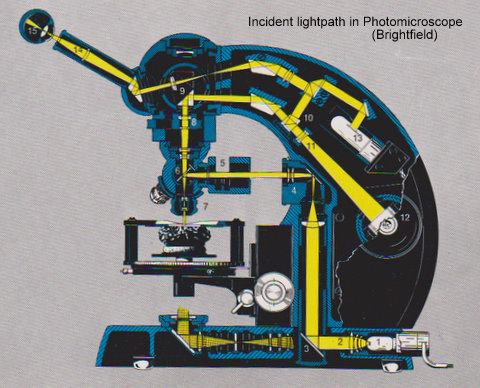
The cross section of the Photomicroscope:
4 – Aperture diaphragm insert
5 – Epi-condenser IIC
6 – Reflector H-PL
7 – Darkfield epi-objective (used in brightfield mode)


|
Matching Different Makes by Fritz Schulze, Canada |
A hobby microscopist and collector will often come into possession of some items that are either incomplete or don’t fit whatever microscopical instrumentation he has. If the microscopist is handy and fortunate to have a well equipped workshop, he or she will try to find ways and means to make these items useable, adapt them to his instruments.
As an avid, not to say almost pathological collector of anything "microscopical", particularly if it is free, I gladly accepted a number of odd objectives from a friend. They had been discarded by an electronics company to be replaced by more modern equipment.
They were 4 epi-objectives (for incident light, for the inspection of microcircuits and chips):
Vickers Microplan 10/0.25 (for brightfield, marked light blue),
Vickers Microplan 25/0.5 met (for brightfield, marked green),
Vickers Microplan 40/0.65 DG (dark-ground, marked green) and
Vickers Microplan 80/0.85 DG (dark-ground, marked dark green).
All four had RMS thread and no indication of the tube length required and came on a quadruple revolving nosepiece.
I have no need for such objectives, nor the means to prepare specimens for epi-observation at higher magnifications (compared to the lower magnifications of stereomicroscopes), but I hate to have parts I can’t use. So the challenge was to adapt these objectives one way or another to my Zeiss Photomicroscope. I already had the Zeiss epi-condenser (vertical illuminator) IIC for individual objectives and the necessary aperture diaphragm insert, a rare item to find. Part of the epi-condenser were reflector inserts: H-PL for brightfield, D for darkfield, H-Pr for polarized light. The Zeiss epi-objectives have the new standard thread M 24/0.5mm and require a small bayonet ring to slip them into the epi-condenser. The larger diameter allows for more light to enter the objectives for darkfield. This light enters the objective in form of an outer cylinder and is directed onto the surface of the specimen by a ring-shaped spherical mirror. The reflected light for observation returns through a smaller central optical system. The Vickers objectives, on the other hand, had to squeeze the light through the much smaller diameter of the RMS thread which meant that I could not use the Zeiss darkfield reflector insert. I had to make a new one. No problem per se, but it required a 45° mirror with an oblong hole. Big problem!
To try and make such a mirror out of glass was out of the question, so I pondered alternative possibilities. That’s where my packrat tendencies came in: I have always saved any little bit that could be of some use and have an assortment of labeled boxes with such "junk", saved in the secure knowledge that sooner or later I would find there just the piece I needed. While digging through the box marked "Small containers" I found a small rectangular powder compact my wife had thrown out earlier and which I had salvaged because it was chrome-plated. It was in fact chrome-plated thin plastic of a surprisingly good mirror quality. Eureka! I cut a wooden block diagonally in half, clamped a suitable piece of that compact box in between the triangular pieces and drilled a 9mm hole through the lot. I had my mirror.
I then manufactured the housing to the same dimensions as the original Zeiss reflector and mounted the mirror at 45° inside. For the cylindrical baffle that separates the incident from the reflected light I machined a piece of copper tubing and carefully inserted it into the oblong hole of the mirror, exactly as it was in the original Zeiss reflector.
The last hurdle was to fit the revolving nosepiece to the Zeiss epi-condenser. To do this I machined a bayonet ring and screwed it to the nosepiece. There was just enough room to slip it in and rotate it to seat it properly. I just have to be careful when I change to another objective that I not inadvertently loosen the nosepiece for it to "fall out".
On trying my new epi-system out on my Photomicroscope I was surprised how well it worked. A few examples are shown below.
The other objectives of the batch were
Olympus IC 10 Neo S Plan 10/0.30
Olympus IC 20 Neo S Plan 20/0.46 and
Olympus IC 50 Neo S Plan 50/0.80.
All are marked ∞/0 f=180 and have the new standard thread M 24/0.5mm. They are of much newer manufacture as the new metric series of magnifications for metallurgy indicates. They are also useable for bright- as well as darkfield and can be attached to the Zeiss epi-condenser by means of the bayonet rings. I can’t figure out, though, what exactly the unusual marking means. Infinity corrected, no cover glass, yes, but why f=180?
It can indeed be a challenge to mate microscope parts of different make but it is gratifying if one’s efforts are crowned with success. My challenge has been met, now the parts lie in my drawer while I await another challenge!
All comments to the author Fritz Schulze are welcomed.
|
The cross section of the Photomicroscope: |
|
|
|
|
|
|
|
|
|
|
|
|
|
|
|
|
Microscopy UK Front
Page
Micscape
Magazine
Article
Library
Published in the March 2012 edition of Micscape Magazine.
Please report any Web problems or offer general comments to the Micscape Editor .
Micscape is the on-line monthly magazine of the Microscopy UK website at Microscopy-UK .
© Onview.net Ltd, Microscopy-UK, and all contributors 1995 onwards. All rights reserved. Main site is at www.microscopy-uk.org.uk .